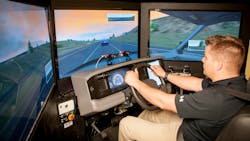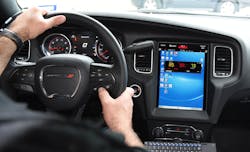The inside of today’s patrol car looks nothing like it did twenty years ago. When Chief Tim Barnes of the Van Alstyne Police Department (Texas) started in law enforcement there was hardly any technology in the car—then over the years came the introduction of radar, computers, cameras, phones and printers. The patrol car today has truly turned into a mobile office, says Barnes, where officers can do almost anything.
At a basic level, the increased technology in the patrol car gives law enforcement the ability to get information quickly, respond to scenes more efficiently and allows more time on patrol, among a plethora of other benefits. But while police officers are tasked with enforcing distracted driving laws in the U.S. for civilians, they themselves are oftentimes distracted by the technology in their own mobile office.
Law enforcement, technology manufacturers and the general public have all noticed that the growing technology has been a distraction for police. To combat this issue, some agencies are re-educating their officers, increasing awareness of the problem and, ironically, adding and modifying technology that limits distractions in the patrol car.
Research-led findings point to key issues
Exactly how much of a problem is distracted driving for law enforcement? In a 15-year average, vehicle collisions kill more cops than assaults do, says Dr. Stephen James, assistant research professor at Washington State University. Several years ago, James and a team of researchers received funding to study the issue of law enforcement safety behind the wheel.
James and his colleague Dr. Bryan Vila brought 80 police officers into their lab for six hours at a time on either two or four occasions. In the initial session scientists brought the officers in twice; once rested and once fatigued, coming in immediately after their last shift. “We wanted to simulate police work as much as we could so we put them on patrol in our driving simulators,” says James. Officers were tasked with following a “lead” vehicle, which was traveling at 55 mph, keeping no farther than 100 feet away. In one of the two drives the officer was asked to interact with a touch screen in the simulator. Around 30 seconds into driving, the officer received a “task” on the touch screen, requiring him or her to scroll up and down to locate a “correct” line of text. Scientists measured the police officers for lane deviation, lane departures, braking latency, following distance and collisions during these simulations.
What the study found is that law enforcement officers drive significantly worse while distracted. “We found that while they are very good at manipulating their other technologies in the cockpit of the patrol car, their driving is still being impaired by the distraction,” says James. “The impact that distraction has on our driving outweighs drowsy driving and DUI.”
Police take note
For years the Brooklyn Park Police Department (Minn.) had issues with officer distractions in the patrol car leading to collisions—one accident every five or six months—including times officers rear-ended each other. “Finally we said ‘This is a real issue’ and we started looking at each case and holding the officers accountable,” says Deputy Police Chief Mark Bruley.
Brooklyn Park PD began focusing on the issue proactively. Making their officers aware of the issue is the biggest thing they’ve done, says Bruley. “The job is already complex,” he notes. “We have to teach [rookies] how to do a domestic, how to do an arrest and we have to teach them how to do all these things in law enforcement. One thing we didn’t do early on but that we’re doing now is teaching them how to manipulate the MDC and the vehicle at the same time.”
Because of the nature of police work, having instant access to technology in the car is a necessity, says Bruley. “But we have to do it in a manner that’s safe,” he notes. “We can’t be driving down the road reading a paragraph.” Brooklyn Park PD trains officers to pick out the necessary information—the address, the cross street, etc.—and to not take their eyes off the road for more than two seconds.
Officers go through a defensive driving program, too. But the police department also made adjustments to the patrol car itself. The MDCs were moved up higher so officers weren’t looking down as much. “We tried to put the MDC in the best place where their eyes can quickly glance over and their peripheral vision can somewhat catch the roadway,” says Bruley. They also placed software in the cadet’s cars that turns the computer screen black when they drive.
Though a number of police departments are making adjustments in the patrol car to lessen distraction, some manufacturers are tackling this issue as well.
Technology to curb the distraction, focus on safety
Several years ago, Gayle DeRose, COO at L-Tron Corporation, traveled to a tradeshow and began hearing that some officers were taking their MDTs with them to the side of the car, leaving two hands unavailable. “No one was talking about technology as a distraction in the patrol car,” she says. So DeRose started doing research. “It was driven by our desire to increase safety for officers.” The company got to work seeing what they could help with, and created the 4910LR for e-Citations. “Before, a handheld scanner was a danger because there was no way to secure it in the car. It was tethered to a cable so what we did is come up with the purpose built 4910 that hooks securely and police can get to it quickly,” she notes. L-Tron’s focus has been helping officers increase their situational awareness in order to increase safety. “The true value of the 4910LR DL reader is to speed up the citation process—reducing their time on the side of the road by more than 50 percent,” says DeRose.
An emphasis on safety has also been key in the development of Stalker Radar’s new Virtual Display. “Historically, police radar required officers to take their eyes off the road,” says Russell Kautz, CTO and VP of Engineering at Stalker Radar. “They also required that officers remove one hand from the steering wheel to operate. The new Virtual Display’s radar is controlled through auxiliary buttons on the steering wheel, allowing the driver to keep both hands on the wheel while leaving the windshield area free of visual distractions.”
Other manufacturers are offering solutions to curb distracted driving by modifying technology in the car. VuLock from Mobile Mounts is software that blanks the computer screen and stops interaction with the keyboard and/or mouse when a patrol car is in motion. The software can be modified to allow critical applications like CAD to still flow through, says Chris Humphrey, vice president of sales at Mobile Mounts. “The chief or captain can work with IT to determine at what driving speed the software is enabled and what applications come through,” he says.
Where to go from here
The patrol car is truly an office. “Citations aren’t in the citation book anymore, they are printed out on the computer. You don’t call the office to have them run a name check or a record. You have access to drivers’ licenses and you have everything on the PC in the car,” says Bruley. Despite the fact that technology can cause distraction, Bruley says it’s an issue that’s seeing improvement, at least in his department. “We are in a better place today than we were four of five years ago when all of this technology started pouring on top of us,” he says.
Bruley notes that they are doing better to mitigate the risk because accidents are down, but that doesn’t mean they’re not without risk—there are improvements that can be made. Some of the improvements don’t seem too far away. “At some point we believe the screen will be projected on the windshield,” Bruley predicts. “That is the future—where these officers will answer a call that shows up right in front of them on the windshield. I’m not sure how far away that technology is, but it doesn’t really even seem that futuristic.”
James from the Washington State University lab couldn’t agree more. “The way the data is displayed in a patrol car is terrible,” he says. “When you look inside a cockpit of a fighter jet, every system in that aircraft is designed to bring the pilot’s attention outside of the cockpit. There are switches that are certain shapes and feels so the pilot never has to look down and the information is displayed on the cockpit head up display so they never have to take their eyes away.” James can’t help but wonder if perhaps too much is asked of police officers. “We know that distracted driving is bad, but we say it’s okay if you’re driving an emergency vehicle and that’s an odd place for our society to be in,” he says.
Law enforcement has a really difficult challenge when it comes to determining policies and practices for operating technology in the patrol car.
James recalls that after his research was published, the local police chief took him to lunch and asked him if the department should pass a policy that bans its officers from using technology when driving. “Law enforcement is a really particular group where they have to get to a situation reasonably quickly, but they also need to get there with the relevant information on hand,” says James. “So while the initial reaction to banning technology could be ‘Of course’, the problem there is that for the tragedies that you stop or prevent because the officers are no longer distracted, we don’t know what tragedies we may initiate because officers aren’t getting the information they need. Not giving them the information may be harmful in a different way.”
The challenge going forward involves finding a balance between how officers get the information they need, without it impacting their driving performance.

Adrienne Zimmer | Editor
Adrienne Zimmer was the Editor of Law Enforcement Technology magazine, a monthly business-to-business publication that covers technology trends and best practices for public safety managers from 2017 to 2019. LET is part of Officer Media Group, which also publishes Law Enforcement Product News and Officer.com. Adrienne has been in publishing since 2013.




